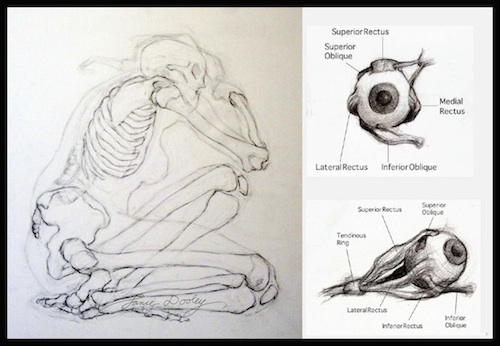

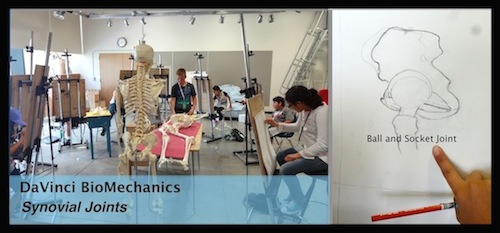
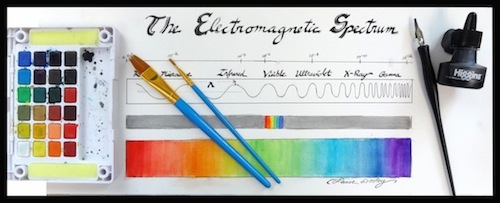
This course combines art and science by creating beautifully crafted watercolor diagrams that explain the various physical properties of light.
Background information for the physics and math behind each lesson will be presented to those who are scientifically inclined, along with important historical footnotes about the people who advanced our understanding about the physics of light.
Students will take home intelligently designed colorful watercolor renditions of what they learned in class as they follow step-by-step instructions from the instructor in a relaxed and informal learning environment.
GRADE LEVELS: HS - College
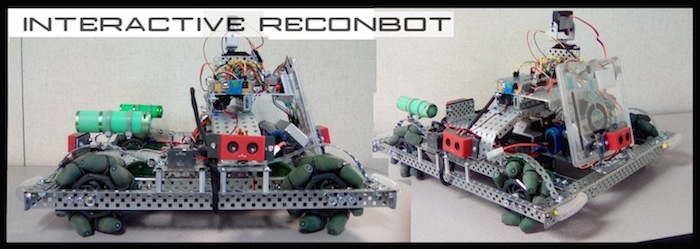
This expansive course introduces students to the fascinating and rapidly growing world of robotics.
There are many different technical levels in robotics, with
resources & knowledge pulled in from a wide variety of fields.
The study of robotics falls squarely into the "Maker" category of learning and doing.
GRADE LEVELS: Middle School - College
The following is a partial list of the abilities and knowledge the learner experience:
~ Software Programming (RobotC, C, C++, Java)
~ Integrated Development Environments (RobotC, Arduino, Android Studio, Eclipse)
~ Microcontrollers and Embedded Applications
~ Electronics and Circuit Theory
~ Realtime Systems, Crystal Clock Speeds, Infinite Loops
~ Math: Algebra, Discrete Mathematics Series, Binary & Hexadecimal, Boolean Logic
~ Signal Processing (Analog & Digital)
~ Physics (Statics, Dynamics, Electromagnetics)
~ Art: Technical Drawing, Creative Drawing & Concepts

This fundamental course explores how electrical circuit theory and how electrical
circuits are put together. Both Analog and Digital circuits can be taught, depending
upon the needs of the learner.
GRADE LEVELS: Middel School - College
The following is a partial list of the topics:
~ Voltage
~ Current
~ Resistance
~ Capacitance
~ Inductance
~ High Pass Filters
~ Low Pass Filters
~ Transistors (MOSFET IGBT)
~ Integrated Circuits (using, not designing)
~ Circuit Symbols

This course shows the learner how to combine different electrical and mechanical
components together to
create functional systems. Sensors and actuators are
combined with microcontrollers to create a system that performs
a task based upon programmed input or user input (or both).
GRADE LEVELS: HS - College
The following is a partial list of the topics:
~ Sensors
~ Actuators
~ Control Systems & Feedback Loops
~ User Interface Design & Implementation
~ Gears
~ Creating Prototype Circuits
~ Packaging Circuits
Every point mass attracts every single other point mass by a force pointing along the line intersecting both points.
The force is proportional to the product of the two masses and inversely proportional to the square of the distance between them.
ref: gravity wiki
A gravity well is a conceptual model of the gravitational field surrounding a body in
space; the more massive the body, the deeper and more extensive the gravity well associated with it.
The Sun is very massive, relative to other bodies in the Solar System, so the corresponding
gravity well that surrounds it appears "deep" and far-reaching.
The gravity wells of asteroids and small moons,
conversely, are often depicted as very shallow.
Anything on the surface of a planet or moon is considered
to be at the bottom of that celestial body's gravity well, and so escaping the effects of gravity from
such a planet or moon (to enter outer space) is sometimes called "climbing out of the gravity well".
The deeper a gravity well is, the more energy any space-bound "climber" must use to escape it.
ref: gravity well wiki
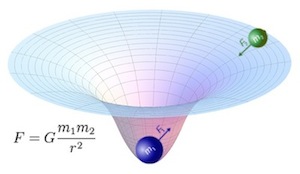 |
A diagram, which may be helpful to understand how a gravity well works. The mathematical formula for the force exerted on two masses, given their masses and distance between them. The masses are shown with the respective positions in a gravity well, the larger mass being in the center fo the gravity well, as our Sun is. |
